Related Research Articles
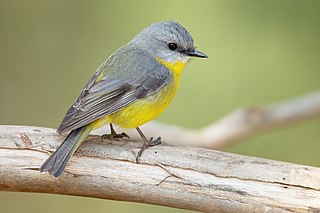
The eastern yellow robin is an Australasian robin of coastal and sub-coastal eastern Australia. The extent of the eastern yellow robin's residence is from the extreme southeast corner of South Australia through most of Victoria and the western half of New South Wales and north as far as Cooktown. Tropical Northern Queensland birds are mainly restricted to the warm heights of the Great Dividing Range.
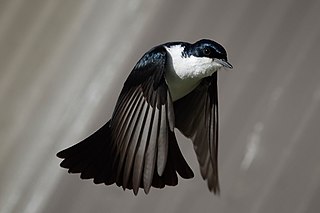
The restless flycatcher, or restless myiagra, is a passerine bird in the family Monarchidae; it is also known as the razor grinder or scissors grinder because of its distinctive call. It is a native of eastern and southern Australia. Populations in New Guinea and northern Australia, which were at one time considered to be a subspecies, are now accepted as a separate species, the paperbark flycatcher. It is a small to medium-sized bird and has similar colouring to the willie wagtail.

The varied lorikeet, is a species of parrot in the family Psittacidae that is endemic to the northern coastal regions of Australia. It is the only species in the genus Psitteuteles.
The northern scrub robin is a species of bird in the family Petroicidae. It is found in northern Cape York Peninsula. It was found to be genetically distinct from the Papuan scrub robin, which were thought to be members of the same species.
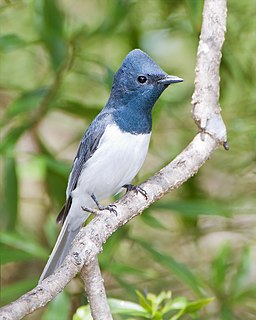
The leaden flycatcher is a species of passerine bird in the family Monarchidae. Around 15 cm (6 in) in length, the male is lustrous azure with white underparts, while the female possesses leaden head, mantle and back and rufous throat and breast. It is found in eastern and northern Australia, Indonesia, and Papua New Guinea. Its natural habitat is subtropical or tropical mangrove forests in the northern parts of its range, in the south and inland it is eucalypt woodland.
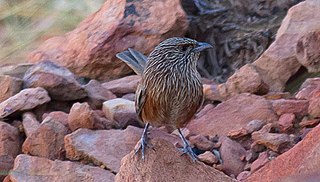
The Kalkadoon grasswren, also called the Ballara grasswren, is a species of passerine bird in the family Maluridae. It is endemic to Australia.

The western wattlebird is a passerine bird in the honeyeater family, Meliphagidae. It is restricted to south-western Australia.

The chowchilla is a passerine bird in the family Orthonychidae. It is endemic to Australia.

The Lord Howe silvereye, also known as the Lord Howe white-eye, Lord Howe Island white-eye or, locally, as the "Little Grinnell", is a small bird in the white-eye family, Zosteropidae. It is a subspecies of the silvereye, though sometimes considered a full species. It is endemic to Lord Howe Island in the Tasman Sea, part of New South Wales, Australia.

The Arafura fantail, sometimes known as the wood fantail, inhabits the Lesser Sunda Islands, the northern coast of Australia from the Kimberley to the western side of the Cape York Peninsula, including subcoastally in the Top End of the Northern Territory, and southern New Guinea. It is similar to the rufous fantail, from which it has been split taxonomically but, apart from minor overlap in the eastern Moluccas, their geographic ranges are discrete. It is generally duller than the rufous fantail with the rufous colouration more restricted.

The Lord Howe fantail, also known as the Lord Howe Island fantail or fawn-breasted fantail, was a small bird in the fantail family, Rhipiduridae. It is an extinct subspecies of the New Zealand fantail. It was endemic to Lord Howe Island in the Tasman Sea, part of New South Wales, Australia.

The Lord Howe currawong, Lord Howe Island currawong or Lord Howe pied currawong, is a large and mainly black passerine bird in the family Artamidae. It is endemic to Lord Howe Island in the Tasman Sea, part of New South Wales, Australia, and is a threatened subspecies of the pied currawong.

The Lord Howe golden whistler, also known as the Lord Howe whistler or Lord Howe Island golden whistler, and locally as the “robin” or “yellow robin”, is a small bird in the whistler family, Pachycephalidae. It is a subspecies of the Australian golden whistler that is endemic to Lord Howe Island in the Tasman Sea, part of New South Wales, Australia.

The Norfolk golden whistler, also known as the Norfolk Island whistler or Norfolk Island thickhead, and locally as the “tamey”, is a small bird in the whistler family, Pachycephalidae. It is a subspecies of the Australian golden whistler and endemic to Norfolk Island, an Australian territory in the Tasman Sea, between Australia and New Zealand.

The Norfolk robin, also known as the Norfolk Island scarlet robin or Norfolk Island robin, is a small bird in the Australasian robin family Petroicidae. It is endemic to Norfolk Island, an Australian territory in the Tasman Sea, between Australia and New Zealand.
Leslie Christidis, also simply known as Les Christidis, is an Australian ornithologist. His main research field is the evolution and systematics of birds. He has been director of Southern Cross University National Marine Science Centre since 2009. He was assistant director at Sydney's Australian Museum from 2004 to 2009.

The Kimberley honeyeater is a bird in the honeyeater family, Meliphagidae. It was formerly lumped with the white-lined honeyeater but, based on a genetic analysis, it is now considered a separate species. Articles published in 2014 and 2015 provided evidence that the Kimberley and white-lined honeyeaters differ not only genetically, but also in song and foraging ecology. The specific epithet honours the Australian chemist and ornithologist Dr Julian Ralph Ford (1932-1987).
Ian James Mason is an Australian ornithologist and taxonomist who is Senior Collection Manager for the Australian National Wildlife Collection. He is an authority on oology.
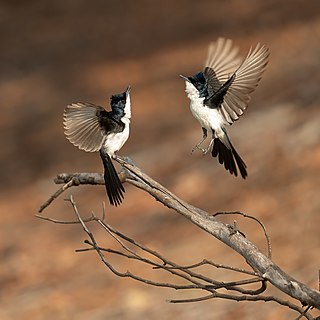
The paperbark flycatcher, also known as the little restless flycatcher, is a passerine bird in the family Monarchidae. It occurs in tropical woodland and riverine habitats of northern Australia and southern New Guinea. Previously, some authorities lumped the paperbark flycatcher as a distinctive subspecies of the restless flycatcher of southern and eastern Australia, with which it forms a superspecies.
The Roper River scrub robin, also known as the allied scrub robin, is a putative subspecies of the northern scrub robin, a bird in the Petroicidae, or Australasian robin family. Whether it ever existed is doubtful; if it did it is almost certainly extinct.